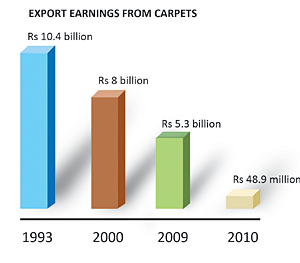 |
 PICS: BIKRAM RAI |
It is the same story at carpet centres across the Valley. An industry that during the 1980s brought in one-third of Nepal's foreign currency earnings is nearly finished. At its peak, there were 3,000 carpet weaving centres employing 1.2 million people. Only 600 firms remain, providing jobs to less than 100,000 people.
"It has been a story of decline and decay," says despondent general manager of the JHC, Chime Dorjee, "export orders have dropped and we depend only on meagre retail sales."
 |
The rise and fall of Nepal's carpet industry is the same old story of everyone getting into the act, the production glut leading to lowered prices just as Chinese carpets became cheaper. There were other problems: the child labour and environmental controversies, government indifference and interference, inflation and labour issues.
It has got so bad that unless the government acts in regulating the industry, we soon won't have any carpets to export," laments Tenzin Choegyal, chairman of Nepal Carpet Enterprise.
The industry is exactly 50 years old, and has its roots in the weaving skills brought to Nepal by Tibetan refugees fleeing the Chinese takeover of Tibet in 1959. The Swiss Red Cross along with Swiss Agency for Technical Assistance set up the Jawalakhel Handicraft Centre in 1960 so the refugees would have jobs. Carpet centres were also set up in Pokhara, Dhorpatan and Solu Khumbu.
 |
Tibetans working for the JHC weaved at home during their free hours, and they slowly started training local Nepali helpers spreading the technique to Nepalis. At its peak in 1993 the carpet industry brought in more than Rs 10.4 billion, but by 2009 it had shrunk by half.
Choegyal, who has been in the business for 30 years, says the biggest problem now are politicised unions. "Labour is our major concern now," he says, "every now and then labour unions backed by political parties come up with unreasonable demands that we cannot fulfil and this hinders production." The best weavers have moved to the Gulf and there is a shortage of skilled workers.
 |
The fierce competition from Indian and Chinese rugs isn't making it easier. "Although, we cannot compete with India and China in terms of price, we are unbeatable in terms of quality especially in America," explains Cheogyal.
If the government stepped in to save the carpet industry, it still has a great potential for growth. The Made in Nepal brand is strong and the added "Tibetan" label gives Nepali rugs an edge that could translate into premium prices.
But carpet traders say the lack of incentives for an industry that has the potential to create tens of thousands of jobs is keeping it hamstrung. Successive governments since the mid-1990s have been interested only in extracting either taxes or bribes from the industry. The government also has an important role in depoliticising union activity, and the competition between politically-affiliated unions that have wrecked the industry, they add.
Left alone
 |
Read also:
Ungentle with refugees, ANURAG ACHARYA


